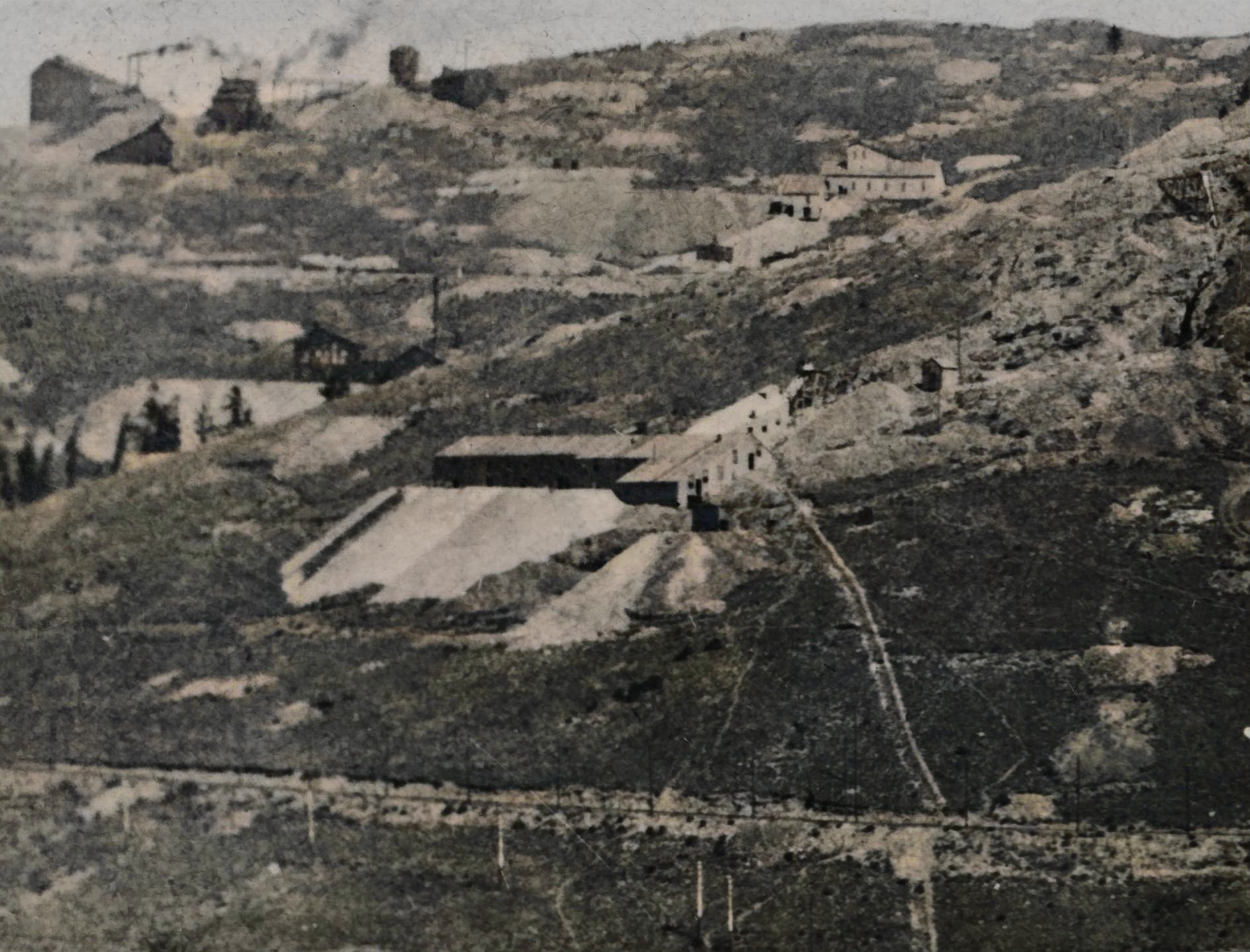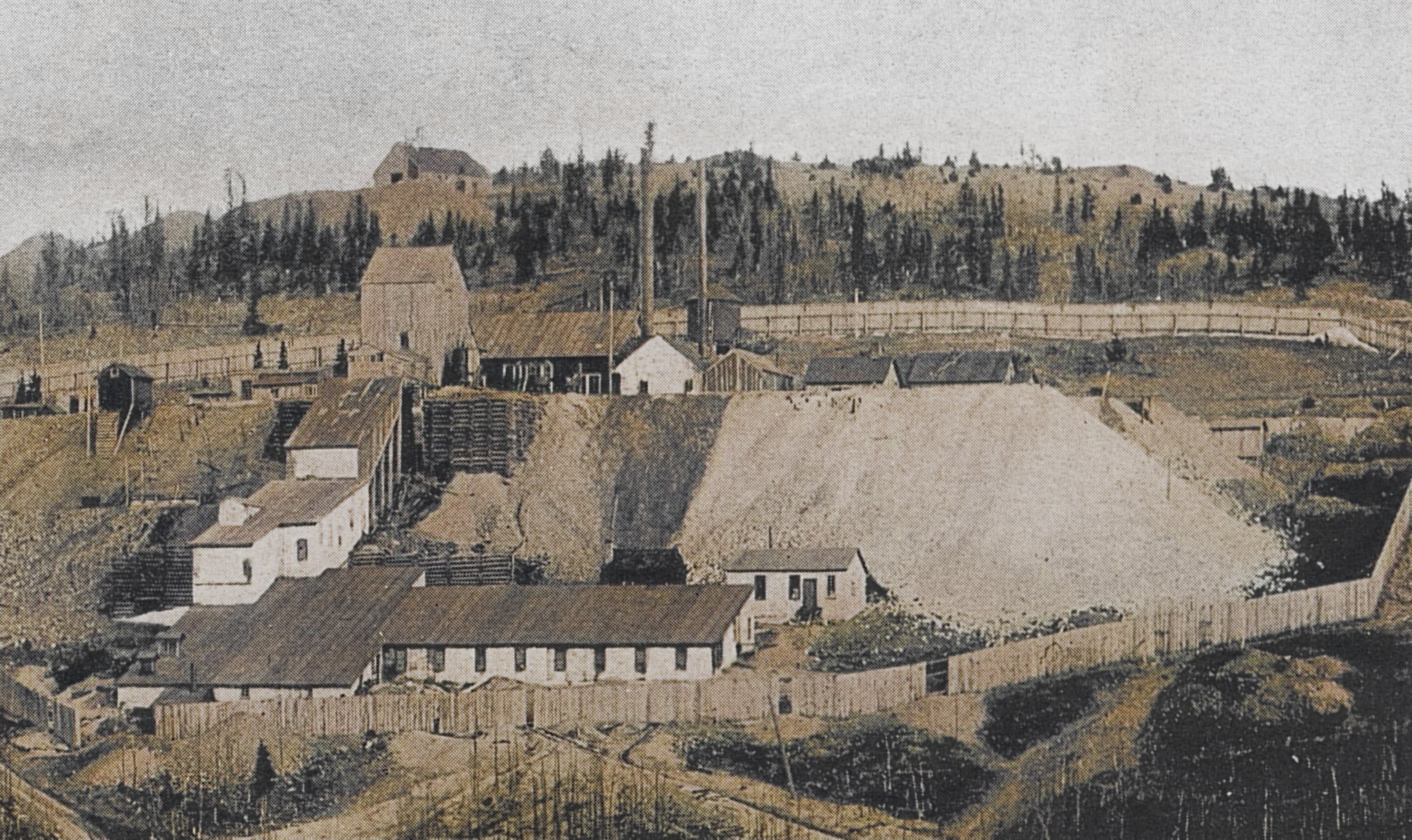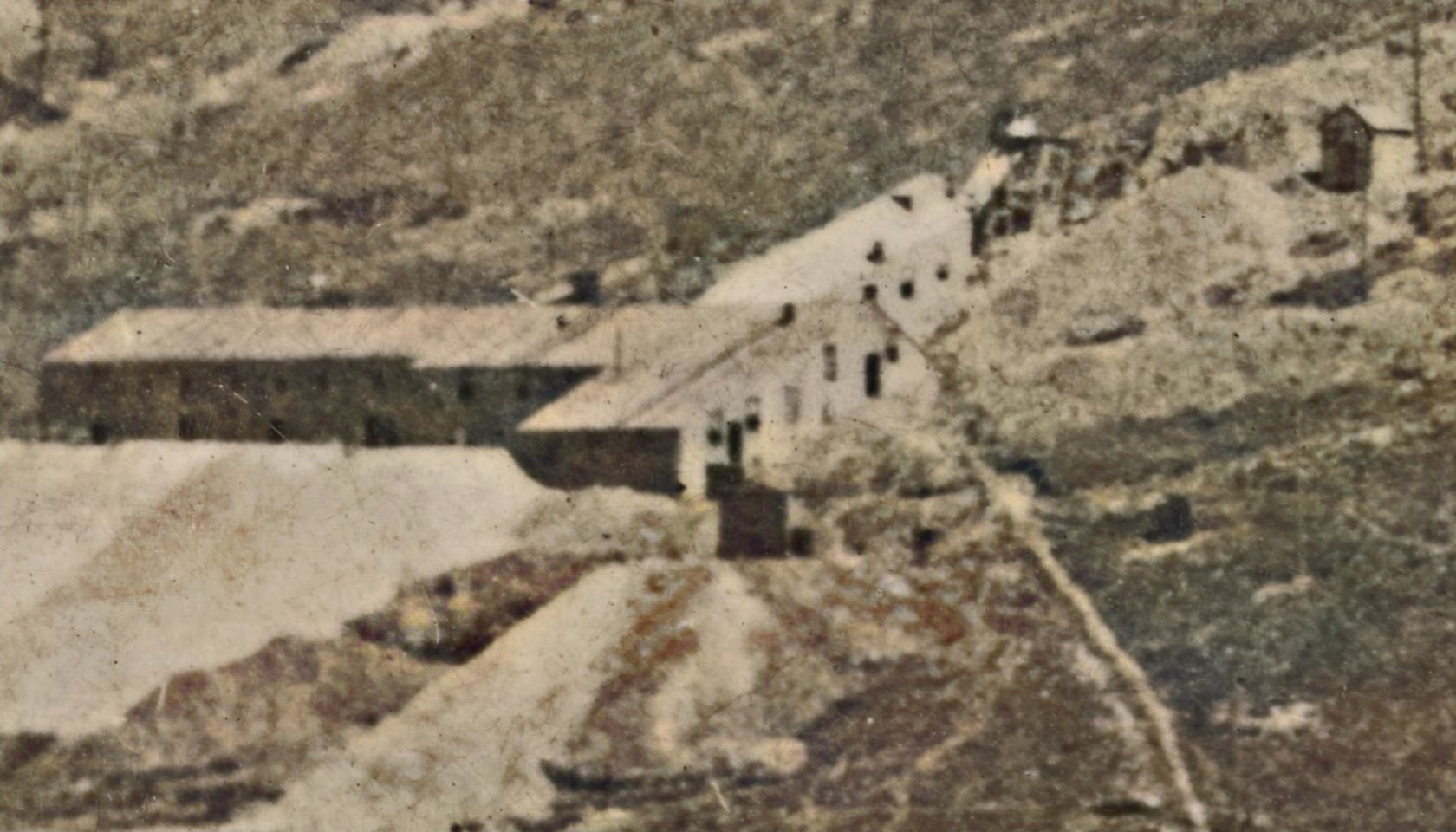-> HathiTrust Digital Library Site; Link to First Page.
Source had no pics, so I used pics from my collection
Until a comparatively recent date the cyanide practice has found very little application to ores of the Cripple Creek district and the tonnage of ore treated to as yet comparatively low. This is due to several causes.
In the first place the district has been one of high-grade propositions, calling for a higher degree of extraction than is usually obtained by the cyanide process and warranting a more expensive method.
Moreover, the common form of occurrence of the gold in the district is in the form of the telluride, calaverite, which is not amenable to cyanide treatment.
A partial oxidation of the ores results in the formation of cyanicides from the associated sulphides, and another difficulty is presented in the shape of the soluble sulphates formed.
From these considerations it is seen that a complete oxidation of the mineral is necessary for the best application of the cyanide process, and it is thus limited almost entirely to surface ores, or to where conditions have been especially favorable to oxidation.
At the present writing only two mills are in active operation in the district, the Homestake cyanide plant located at Ironclad hill and the R. E. A. and A. Co.'s mill, generally spoken of as the Wild Horse mill, on Bull mountain.
One, the Lois mill of the Sioux Falls Company, has been in active operation since November, 1903, and is only temporarily closed down for repairs.
The Cripple Creek Cyanide Company have just completed a mill at Gillett and expect to commence operations soon.
King and Craig of Cripple Creek have a mill in course of construction at Anaconda and expect to begin treating ore by September 1st.
The process has been tried on tailings from an old chlorination plant at Gillett, but unsuccessfully, and the plant is now abandoned.
The Homestake and R. E. A. and A. Co.'s mill were erected under the supervision of Mr. H. F. A. Riebling, who at present has charge of the R. E. A. and A. Co.'s mill. Both of these mills have commenced operations within the year, so that it may be seen that the practical application of the cyanide process in the district is less than a year old.
Just what its future development may be is hard to foretell, but the present outlook seems rather favorable than otherwise.
The general scheme of ore handling as practiced in the two mills mentioned as being in active operation is practically the same and may be represented graphically as follows:
1. The ore is trammed to bins, from whence it is drawn to pass over a bar grizzly with one-inch spaces.
2. The oversize goes to the gyratory crusher. The undersize goes to a revolving trommel of eight-mesh.
3. The oversize goes to the first set rolls, undersize to the finished product bin.
4. Crushed material from the first rolls goes to revolving trommer, eight-mesh. The oversize goes to the second set of rolls, undersize to the finished product bin.
5. The material from the second rolls goes to revolving trommel, eight-mesh, the undersize from which goes to the finished product bin, the oversize to finishing rolls, which also delivers to the finished product bin.
It will be seen from this that the crushing is only to eight mesh and that it is aimed to take out the finished product at each crushing operation and thus relieve the crushing machinery and also prevent the formation of an undue amount of slimes.
The coarse crushing employed points to the coarse dissemination of the gold through the rock, and at present the Homestake mill is replacing the eight-mesh screens with four-mesh, and claims the extraction to be as good.
This fact, if holding for all of the ores, is extremely favorable as reducing the cost of crushing and at the same time giving a readily leachable product.
The Homestake Company uses six iron leaching tanks of about 100 tons capacity, and this is the average size of the tanks used in the district. The Gillett mill has tanks of 130 tons capacity, and the Lois of only seventy-five tons.
The depth varies from five to seven feet, and in this respect it is suggested that in consideration of the coarse crushing practiced a much deeper tank might be employed without materially affecting the leaching. The amount of floor space required could thus be materially reduced.
The following table gives in a condensed form the data for the different mills:
| Homestake Mill |
R. E. A. & A. Wild Horse Mill |
King & Craig Anaconda Mill |
Cripple Creek Cyanide Co. Gillett Mill |
Lois Mill Sioux Falls Mill |
|
| Capacity of mill (tons) | 200 | 90-100 | 150 | 130 | 75 |
| Number of tanks. | 6 | 4 | 6 | 6 | 4 |
| Capacity of tanks (tons). | 100 | ? | 100 | 130 | 75 |
| Strength of solution used. | ? | varies | .... | .... | varies, average 4 lb. |
| Value of ore tested. | ? | varies | $9.00 | .... | $4.00 |
| Length of treatment (hours). | 60 | 72 | .... | .... | 36 |
| Percentage of extraction. | 85-90 | 92 | .... | .... | 75-80 |
| Cost of mining and milling | $1.02 | .... | .... | $1.30 | |
| Fineness of crushing (mesh) | 8 | 8 | 6 | 8 | 6 |
The capacity of the mills will, when not governed by the crushing department (which is usually in excess of the leaching department) vary with the length of leaching, which is not regular in any of the mills.
None of the mills have been in operation long enough to have established fixed conditions of treatment, and, in fact, the character of ore usually varies in the same mill so as to render uniform treatment impracticable.
The ore usually calls for the addition of some lime to neutralize the acidity.
Dry crushing is practiced in all of the mills and is undoubtedly preferable where the product required is coarse and no separation of sands and slimes is necessary for treatment. The following diagrams show the process of crushing employed in the Lois and Gillett (Cripple Creek Company's) mills, respectively.
LOIS MILL.
1. From bins the ore goes to bar grizzly with half-inch spaces.
2. The oversize goes to gyratory crusher, the undersize to an elevator delivering to a six-mesh shaking screen.
3. The material from the gyratory crusher joins the undersize from the grizzly.
4. The oversize from the shaking screen goes to rolls, the undersize from the screen goes to an elevator which delivers to finished product bin.
5. The crushed material from the rolls also goes by elevator to finished product bin.
6. From finished product bin the material is trammed to tanks.
GILLETT MILL.
1. From bins the ore goes by belt conveyor to grizzly with inch spaces, the oversize from which goes to gyratory crusher and the undersize to the first rolls.
2. From the first rolls crushed material goes to eight-mesh screen, which delivers undersize by belt conveyor to elevator, and thence to finished product bin.
3. The oversize goes to finishing rolls, which joins the undersize from the preceding trommel to finished product bin.
4. From these bins the material is delivered by chutes to the leaching tanks.
It will be seen from these that the crushing plants are comparatively simple. Especially is this true for the Lois mill, where the entire crushing plant consists of one gyratory and one set of rolls. The Gillett plant is, in some respects, unique, as are also some of the methods of treatment which it is proposed to employ.
It will be seen from the scheme of crushing that the finished product is passed over an eight-mesh screen and the undersize and oversize go to separate bins. The advantage to be derived from this is difficult to see, as the entire product should be readily leachable without any slime treatment.
It is proposed to spray the ore as it enters the bins with bromo-cyanogen solution, to serve the double purpose of settling the dust and assisting in extracting the values. It is further proposed to heat the solution in the tanks by means of compressed air introduced at the bottom after passing through iron pipes heated by passing through a fireplace, the air to serve the double purpose of heating and furnishing oxygen to the solution.
As the plant has not yet started operations the value of this method of treatment can only be speculated upon. But the benefit to be derived seems rather doubtful, as heating the solution to anything above ordinary summer temperature would probably result in an undue loss of cyanide without a proportionate increase of extraction.
The loss of cyanide in the mills in operation is not excessive. At the Lois mill the loss is said to amount to almost nothing. A failing off in the strength occurs during the first few hours of treatment and afterwards the strength again increases to nearly the original amount, an apparent regeneration of cyanide taking, place within the vat.
The Homestake people claim to use a solution of only one pound to the ton, and to sustain a loss of 0.28 pound during treatment. The value of ore treated is not given by the company, but is claimed by outside parties, who have made assays on the ore, to be less than $2 per ton.
The fact that the company is now engaged in erecting a new 1,000-ton addition to their plant would seem to indicate the success of the plant now in operation.
It may, however, as is claimed by some outside parties, simply indicate a successful scheme of stock speculation.
If it be true that ore below $2,00 per ton can be treated at a profit by the cyanide process. it would certainly seem that the method has a bright future on the low-grade surface ores of the district.

Cropped Gold Hill View with Anaconda Mill; Rittenhouse; E. Porter Gold King; Lexington; Anchoria-Leland Mines
The King & Craig Company have an immense amount of surface ore in sight which is said to have given an average value on several hundred assays of about $9 per ton. With proper facilities for handling and crushing there seems no reason why the ore should not be treated at less than $2 per ton.
Laboratory tests on the ore give an extraction of 98%, a result which can scarcely be hoped to be attained in actual practice.
The method of precipitation in all of the mills is the ordinary one by means of zinc shavings, and no particular difficulty in this direction seems to have been encountered.


